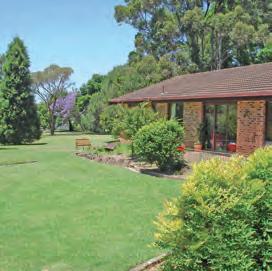
41 minute read
Reflex in babies Causes and treatment options
Reflux in babies causes and treatment options
BY DIANA ARUNDELL – UNIVERSITY QUALIFIED NATUROPATH
It can be difficult enough trying to settle into life with a baby even when there’s no additional health concerns, and when extra issues present themselves it can be extremely challenging for new parents. Often it’s a combination of not knowing what’s actually wrong with the baby as well as the extra fatigue dealing with the issue and the emotional upset of seeing your baby in pain. Reflux and silent reflux is a classic example of this. Reflux is often transitional and can affect almost half of all babies with a small percentage of babies experiencing more severe reflux having more than 6 episodes per day. Reflux is one way the gastrointestinal tract can let us know that something needs some attention and that can include what is being consumed and/or how it is being consumed.
Reflux is recognised in a baby when they frequently vomit up their milk and there is discomfort and pain associated with this due to stomach acid that comes up with the milk creating a burning feeling in the oesophagus. Silent reflux is when the acid still makes its way up and irritates the oesophagus but it is not necessarily accompanied by the vomiting
which can make it even more difficult to diagnose.
There are a number of reasons a baby may experience reflux and these include both structural or functional reasons as well as those related to certain food triggers such as allergies and intolerances. A baby’s gastrointestinal tract is brand new at birth and it can take time to mature. The baby’s gastro intestinal tract is suddenly directly exposed to new molecules via breast milk or formula, and not only does it have to get used to the increased volume of what’s coming in, it needs to digest and absorb the new molecules it’s being exposed to. Just like us, babies have acid in their stomachs to break down protein and other nutrients, and the stomach has a protective mucous membrane lining to protect itself from this acid. There is a valve at the top of the stomach to prevent this acid from rising up into the oesophagus (which doesn’t have this
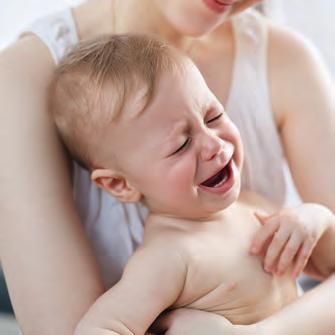

protective mucous membrane lining) and it can take time for this valve to mature in babies. For those with mild or infrequent reflux, most babies grow out of it by 12 months but if it is severe it needs to be investigated further as it may be more than just an immature valve or too large portions of food being consumed in one sitting.
Some things that may help improve reflux due to structural reasons include checking with your lactation consultant about feeding
positions and also ruling out tongue or lip tie as these can contribute to reflux. Feeding smaller portions at a time, keeping your baby upright after feeding and also elevating your baby’s chest and head slightly for sleep can help and improvement will often be noticed fairly quickly. If reflux is occurring due to dietary triggers it can take a little more detective work to establish the cause and if the baby is exclusively breastfed it
becomes all about what the mother is eating and drinking. 30% of babies with severe reflux have issues with cow’s milk protein so this should be the first thing investigated. The breastfeeding mother can eliminate dairy (cows milk, yoghurt, cheese) for a period of 14 days and observe changes with the reflux. If the reflux improves the breastfeeding mother can then re-introduce yoghurt, cheese and milk one at a time, a few days apart and observe if the reflux returns with only one or all of the potential triggers and the diet can be adjusted accordingly. Babies drinking cows milk formula can try goats milk formula as an alternative, as goats milk protein is often more tolerable in sensitive babies. If dairy is not tolerated at all and the baby is formula fed, there are dairy free options available. For breastfeeding mothers and older babies, if dairy is not tolerated there are many other excellent sources of calcium such as green leafy vegetables, nuts and seeds, nut butters, tahini and sardines.
If eliminating dairy doesn’t improve the reflux, some other common food irritants are wheat containing food and high salicylate containing food. It’s best to undergo any elimination diet especially when breast feeding or treating a baby, under the strict guidance of a qualified, experienced nutritionist or naturopath as it’s important to be aware of all nutrient groups that are required for the healthy growth and development of the baby. Experienced naturopathic practitioners can also prescribe natural medicine to help soothe and support the gastrointestinal health of the baby. Simple remedies such as strong infusions of chamomile and fennel tea for the breast feeding mum and probiotics for both mum and baby can make improvements, and there are a number of stronger medicinal herbs which are safe and effective for treating babies with reflux and other gastrointestinal discomforts which can be prescribed by an experienced practitioner.
There is always a time and place for pharmaceutical grade medications and sometimes it may be the best and only option. However in the case of reflux (as opposed to acute life threatening conditions) there are several other natural medicines and approaches which may be worth trying first, as there are some undesirable side effects that may occur with taking pharmaceutical reflux medications longer term. For example the minerals iron and calcium are broken down and absorbed in the stomach and when pharmaceutical ‘ant acids’ are prescribed to reduce
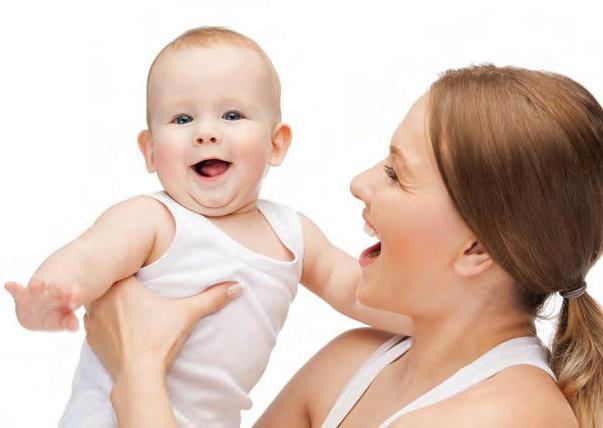
stomach acid, it can lead to reduced absorption of iron and calcium which are two very important nutrients for babies and children. These medications should be a last resort when all other options have been thoroughly investigated first. As with any medication, read all ingredients and inserts so you are fully aware of what you are putting in your baby’s body.
Whether your baby experiences mild or severe reflux, it needs to be addressed to help your baby become more comfortable. Working together with your doctor and naturopath can
offer the best comprehensive approach.
Diana Arundell is a university-qualified naturopath and consults from her Avoca Naturopath clinic. She has a special interest in fertility and pregnancy health, digestive health, immune function and family wellness programs. She was a nutrition lecturer at Macquarie University for 10 years, and is an accredited Journey Practitioner. For further information please contact Diana Arundell at Avoca Naturopath on 0410 465 900.
BOOK YOUR FREE TRIAL NOW!
Awaken your child to the thrill of sport
readysteadygokids.com.au 1300 766 892 Franchise opportunities available We are Australia’s largest multi-sport program for 1.5–6 year olds! • Learn the basics of 10 great sports • Low child/coach ratios • Physio-designed, structured & FUN!
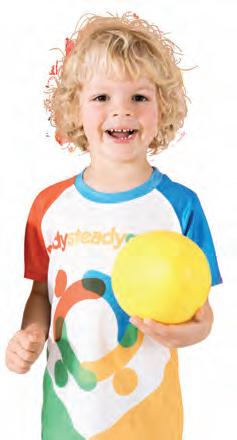


finding you

3 TIPS for mums lost in motherhood
BY CATHERINE SCHASSER
On a leisurely Sunday morning, I wandered into a homeware shop. Clothing, cushions, wall art, furniture & candles were presented beautifully throughout the store. Displayed amongst an array of side-table ornaments and books was a wooden teal block which read, 1. Mum: a woman who loves unconditionally. 2. Mumster: what happens to mum when she counts to three. Meant as a small gesture of well-meaning humour, this little gift got me thinking. What else defines a mother, or more importantly, who is doing the defining? Mothering involves caring and providing for others. It involves sleepless nights and long days, often so full, a hot cup of tea is an unknown. Do you ever feel you wouldn’t know how to reply if someone asked what you did today, yet you know you barely sat down, or when you did, you were providing for the needs of your children, not to unwind as you flick through your favourite magazine? In fact, you can’t remember when you last did that… You cooked, cleaned and attended to what felt like a hundred tasks, yet turned around to see even more to do. You spent the day mentally and emotionally exhausted as you worried about the wellbeing of your children. Sleeping. Toileting. Eating. Behaviour. Confidence. The planning, the remembering and the decision making impacted your energy, not to mention the desire to be present when offering empathy, comfort or calm to your child … constantly. With all of this happening, when were you supposed to find time for you, let alone ‘find you’?
In all the busyness and exhaustion of your days, the expectations and the comparison game, it’s no wonder you’ve lost yourself. And you’re not alone. Social media is going crazy with mummybloggers and influencers sharing images and stories of their ‘normal’ lives. They’re influencers however because mums are tuning in. For some mothers it’s to seek inspiration, for others it’s a chance to live vicariously for just a moment. An opportunity to pretend the perfectly decorated and clean home is theirs, ideally located just a hop, skip and perfectly executed jump from the seaside. Days of calm, harmonious and smiling faces as children cuddle and play in their beige and white brand-name clothing, with not a tantrum or packaged snack in sight. So, what is it mothers are really seeking when, by the thousands, they follow these bloggers? Is it the escape, or
rather a yearning to discover how they too can experience such contentment and a life of their dreams? Whether a seaside escape, a country relocation or a newly renovated home is on your horizon or not, here are my top 3 tips for finding you when you’re lost in motherhood…without escaping to someone else’s highlight reel:
1Design it. Dust the lint from your shoulders and leap into your future. Imagine yourself 3 months, 3 years or 30 years from today and decide who you want to be. In this ideal and perfect world play with the following ideas. Who are you with? Where are you? What can you hear? How do you feel? How do others feel in your company? What words do
people use to describe you? How do you love to spend your time? What truly matters to you?
2Create it. Well done. Knowing who you want to be and how you want to live is V.I.T.A.L to finding you. Now take the ideas you’ve discovered above and come backwards. With those pictured in your future, step by step return from there to the now, and decide what thoughts, words and actions you would need to use to bring that future into reality.
3LIVE IT! This is the big ask. To create any new or better experience, you must prepare, set yourself up for success and COMMIT. Every day on waking, I want you to recall the first two points (what matters to you and what you must think for this to be achieved) and then act on them. Picture yourself being this person now, today. What would be the first thought you would need to have, even before getting out of bed? What would be your first word or action? What would you need to be aware of to continue this intention? The secret to finding you is gaining congruency with your identity.
Motherhood is such a powerful role. It’s even more so, when you implement it as your true self, rather than a version of some non-sensical ideal made up by…who? Who is this imaginary guru mothers are feeling they must impress? Please don’t buy into this. You are uniquely you. The perfect mother for your perfect children, and as importantly, you are a valued and valuable person engaging in this thing called life. You’re doing the best you can. Move through life consciously and with purpose, bringing to the world the gifts only you can.
As you continue to embed these three tips into your days, you will move closer to discovering your true and inspiring identity. What a blessed life that will be.
Sincerely Catherine
Catherine is a mother, life coach, early childhood teacher and is co-founder of Developing Dreams, a locally owned company which provides an Early Learning Centre and Coaching Services for mothers. Please email catherine@developingdreams.com.au or call 4358 3155 for more information.
Burns
what to do

Severe burn injury can be life threatening. Even small burns can be dangerous for the very young.
Babies and young children have fragile skin and their skin burns deeper and more quickly than adults and at lower temperatures.
Majority of burns are PREVENTABLE and by being aware and making small changes, you can help to keep your family safe!
The most common type of burn injury for children aged 0–5 years is scalds. A scald is a burn caused by hot liquid or steam.
Most scald burns in this age group are due to young children mimicking adult behaviour.
This frequently results in burn injuries caused by pulling down hot drinks off tables, reaching up to grab handles of saucepans or by playing with the taps in the bath.
In an emergency call 000 or 112 if your mobile is out of range or credit. For further medical information contact your local Burns Unit or Hospital. 79% of severe burns to children HAPPEN IN THE HOME
What to do if your child suffers a burn
REMOVE Remove all jewellery from around the burn area. Remove any clothing and nappies around the burn area unless it is stuck to the skin.
COOL Cool the burn under cool running water for 20 minutes. Cool the burn, warm the patient. DO NOT use ice or creams as this can further damage the skin.
COVER Cover the burn loosely with cling wrap or a clean, damp lint-free cloth.
SEEK Seek immediate medical advice if the burn is:
larger than a 20 c ent coin
on the fac e, hands, groin or feet
deep or infected
caus ed by chemicals, electricity or if signs of inhalation injury (blackening around mouth or nostrils, swelling of airways) are evident.
Article supplied by
Toukley Family Practice www.toukleydoctors.com.au Mariners Medical www.marinersdoctors.com.au Warnervale GP Super clinic www.warnervaledoctors.com.au Tuggerah Medical Centre www.tuggerahdoctors.com.au Download free app ‘high quality healthcare’ Resources: https://kidsafe.com.au/national-burns-awareness-month
BY SAM & JORDI WOODS 7 steps to feeling sexy and stylish this spring
As winter ends most of us start to think about Summer and (unfortunately) for many of our clients the thought of Summer can be daunting… Summer often means less oversized clothing, baring more skin and sometimes feeling ‘blah’ as you have just come out of months of hibernation under lots of layers.
What if we told you that you could leave your winter hibernation feeling sexy and stylish?!?!
Well you can AND you do not need to lose weight, get a tan, eat more kale or go for a run if you don’t want to. No! You just need to implement our “Seven Steps To Sexy”!
Before we get to the steps there is something you need to understand… What it actually means to be Sexy?
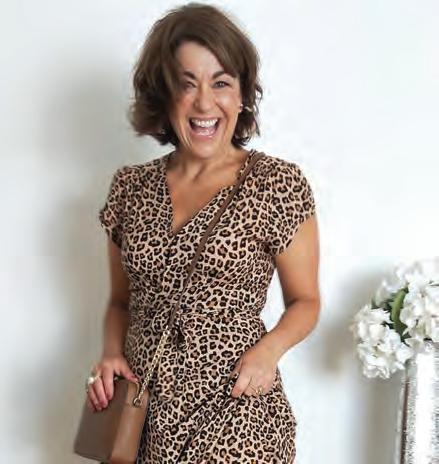
Being sexy means: you are connected to your inner self you have a positive attitude, approach and outlook on life you always flaunt your best curve… your smile! y ou are confident with who you are you feel good about how you look as you know you are doing all you can to feel your best y ou know how to have fun and be playful you don’t dress too revealing but rather leave something for the imagination you have self control y ou are always true to yourself you don’t try to be what you think other’s want you to be you are kind, caring, respectful and except the same in return

Time to embrace YOU Do this by listing below 5 things you find sexy about your soul (your inner beauty)…TIP: refer to the above for list of inspiration!
Sexy things about me internally (personality, soul) are:
1 ……………………………………………...................... 2 ……………………………………………...................... 3 ……………………………………………...................... 4 ……………………………………………...................... 5 ……………………………………………......................
As you can see, “being sexy” really is more about how we feel and act and less about how we look and what we wear. So before we move any further we want you to understand that being sexy is all about…
“Learning how to achieve a healthy self esteem and stylish disposition that ultimately empowers you and enriches your life as a woman.” – Sam Woods. The secret to achieving this healthy self esteem and stylish disposition externally is with the below “Seven Steps To Sexy”!
1Wear a beautiful perfume and/or body lotion – Scent is not only the most powerful memory trigger, it is also another method of expressing our personality and style. Fragrance choice is very personal and differs from person to person, therefore making aroma another physical component of our individualism can compliment and complete our personal style. Tip Don’t just save your fragrance for special occasions, treat yourself and those around you everyday with your signature scent. 2 Walk and stand with poise –Confidence really is the sexiest thing a woman can wear so walk with your head high, tummy in and shoulders back ALWAYS! It is amazing how our body language can effect how we feel and other’s reactions and responses to us. Next time you don’t feel overly comfortable in a situation or an outfit you may be wearing, muster up the confidence to stand tall and walk with assurance and you will be astonished at how differently you will feel and how positively others will respond to you. Tip To get an honest understanding of how you walk, sit and stand, practice these movements in front of a full length mirror. Sometimes how we think we look can be very different to how we actually do, and mirrors don’t lie. 3 Have fun and don’t take yourself too seriously – Life is meant to be enjoyed not endured and it is way too short to spend it being miserable. Unfortunately, life can dish some challenging moments that can be out of our control and some people do get more of a share than others. However, experience has taught us that no matter what we are dealt if we can try to find something positive (no matter how small) from a situation then it can make everything just a little easier. 4 Smile with your eyes – When we smile from our heart our emotions are expressed through our eyes and our entire face seems to radiate. Maybe this
is why it is so hard to smile when we feel sad? Tip Think of someone you love or something that makes you truly happy and smile from your heart through your eyes in front of the mirror, you will be amazed at how gorgeous you look.

5Have a sexy signature colour(s) – These are the colour(s) that make you glow, feel radiant and sexy! Red and black are often synonymous with sexiness, however, not everyone likes or feels attractive or empowered in these shades. Your “sexy” colour will be the colour that no matter what is in fashion you will always find it in your wardrobe. For this reason your signature colour needs to be a hue that is timeless and lends itself to most occasions. Tip It can be any colour you like but most importantly the colour must like you. 6 Apply lipstick – This wonderful cosmetic invention termed “lipstick” has been around since almost the beginning of time and is the perfect tool to draw attention to one of our most important facial features – our mouths. Our mouths and lips allow us to speak our mind, eat and drink and are also very handy when a little kissing is required! Therefore, drawing attention to this area with lipstick has many advantages: it can protect our lips from the sun and wind, give an instant colour lift to the face, assist in expressing our style and mood, and draw attention to where we want people to be looking when we speak. A little smear of lipstick is one of the most fundamental and feminine accessories that can make us look and feel sexy no matter what the occasion. 7 Develop a weekly beauty routine – Set aside “me time” each week and indulge yourself in some home beauty pampering. A DIY facial, manicure, pedicure, hair masque or just some alone time soaking in a warm bath. Nurturing yourself will not only recharge your battery it will get you back in touch with yourself and have you looking rejuvenated and relaxed.
There is no doubt that when we feel good on the inside we look good on the outside, so time to take a look at yourself
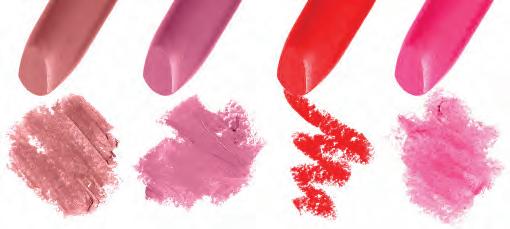
from the inside out. Being sexy is a state of mind and now you have discovered what “sexy” means, what you find sexy about yourself and our “Seven Steps To Sexy” we want you to fill in the below sentence.
I am going to bring my sexy back/ reveal my sexy by:
As this article comes to a close I want to leave you with Sam’s Top 5 Sexy Secrets: Sexy doesn’t have a use by date Sexy doesn’t mean skimpy! Only y ou hold the power to be sexy C onfidence is the key to being sexy Ev eryone won’t think you’re sexy & who cares! Hopefully by now you are feeling empowered and less afraid of coming out of hibernation. We hope you are ready to unleash your sexy with style this Spring.
Vibrantly yours, Sam & Jordi Woods (Mother/Daughter Style Duo) xx
Understanding styling and fashion is one thing. Having a super-natural flair for making everyday people look incredible is another. Once you’ve met Sam & Jordi Woods, it’s hard not to catch their infectious passion for dressing to match your own lifestyle, personality and charisma. Through their consultancy ‘VibrantConcepts’, Sam & Jordi have transformed the lives of thousands. Let Sam & Jordi show you how to look and feel fabulous everyday at their Style Studio in Erina – learn the art of illusion dressing, colour matching, styling, translating fashion trends and savvy shopping with their unique VC Signature Styling Systems and services that are truly personal and really work! To contact VibrantConcepts phone 0425 221 676.
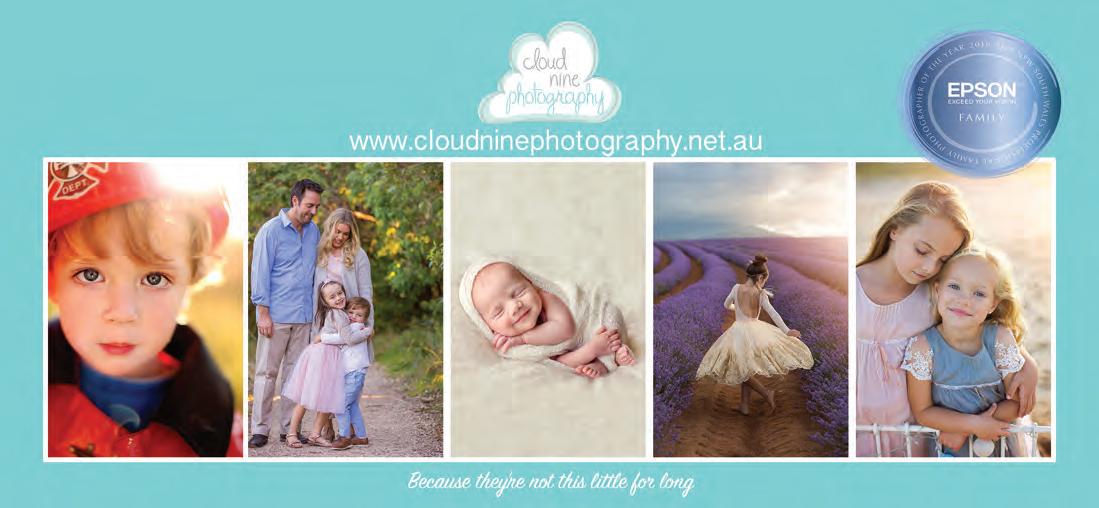
Spotlight on ENT
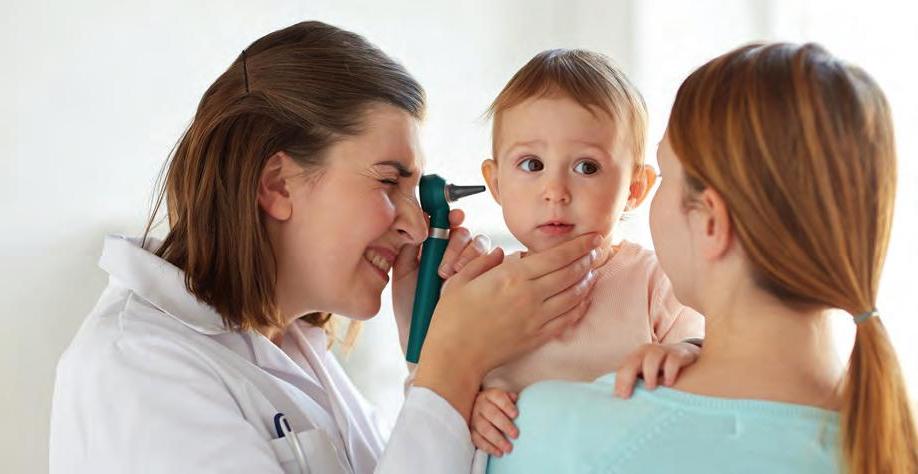
BY DR SAMANTHA PETHEN
Otitis Media ENT is the branch of medicine that applies to all conditions related to the ears, nose and throat. In the first of this three-part series, we will focus on the ears, in particular, otitis media. This is a very common reason for kids to come and see their doctor and, sadly, a leading cause of hearing loss, particularly in developing countries.
What is otitis media? Otitis media is the, short lived, inflammation and infection of the middle ear, which can be caused by a virus or bacteria.
This is the part of the ear that sits behind the tympanic membrane (or eardrum). It contains the three tiny ‘hearing bones’ that transmit sound from the eardrum to the inner ear, and connects to the eustachian tube ending in the pharynx.
Some children develop glue ear (or otitis media with effusion), often after an episode of otitis media. This tends to last a bit longer, sometimes several weeks, in which time a thick, glue like material collects behind the ear drum. It is so thick, it can struggle to drain through the eustachian tube.
Around 75% of children in Australia will have had an episode of otitis media before they start school. It becomes less common as we get older because, in a growing ear, the angle between the eustachian tube and wall of the pharynx changes and coughing and sneezing causes the passage to close, making it harder for infected mucus to move into the middle ear. Also, as the eustachian tube grows, it is easier for mucus to drain back out again.
It is no surprise it happens more in winter, and, interestingly, affects boys more than girls. How do I know if my child might have it? If your child has developed an acute otitis media, you may notice they are tired, they may become irritable, with poor feeding, they could have a temperature, or complain of pain, younger children may pull at their ear. If a doctor examines your child’s ear, we might see a discoloured eardrum that may be bulging, and even have an air-fluid level visible, like a spirit-level!
Other things that may cause pain in the ear include, infection of the ear canal, referred pain from teeth, trauma or the presence of a foreign body, for example a tiny piece of LEGO!
What should I do? If you think your child has an ear infection, take them to a GP. Some children may be sick enough to need to go straight to hospital.
All babies, under the age of 3 months, with a temperature of 38˚C or more, need to be seen in hospital immediately.
Generally, however, most children will be fine with paracetamol and ibuprofen to manage their fever and pain, plenty of drinks and lots of rest. A warm washer over the ear can also help to ease the pain. In most cases, antibiotics are unlikely to make any difference to symptoms but may cause side effects and contribute to antibiotic resistance. If antibiotics are prescribed, be sure to complete the full course as advised, to prevent complications such as mastoiditis. It has been shown that 60% of children will improve in 24 hours, and 80% will improve within three days.
If your child has had more than three episodes in six months, or more than four episodes in a year, it may be time to ask your GP to consider a referral to an ENT specialist. Similarly, if your child has speech, language or developmental problems, with recurrent infections, or glue ear, a specialist may consider inserting gromets (tiny tubes) into the ear drum. These help drain fluid from the middle ear. Surgery aside, repeat episodes can be reduced by avoiding exposure to cigarette smoke, by trying to avoid the use of dummies, and by feeding your baby in a tilted position, rather than flat.
Very importantly, we all need to make sure, if possible, our children are up to date with their immunisations. The introduction of the pneumococcal vaccine has helped to dramatically reduce the incidence of otitis media and its complications.
So…in summary Otitis media is a common condition in young children, with 75% of children having an episode before school age If you are concerned your child may have an ear infection, take them to their GP 60% of cases will improve within 24 hours In most cases antibiotics will make no difference to how bad the symptoms are, or how long the condition persists You must get your child checked again if their symptoms get worse, if their symptoms continue for more than a few days or if you are worried Ask about seeing a specialist if your child has had 3 or more symptoms in 6 months, 4 or more episodes in 12 months, or if your child has recurrent infections or persisting glue ear and speech, language or behavioural issues.
The Magical World of Crazy Science is a delightful mixture of magical visual science demonstrations, illusion and the arts that will have children spellbound!


Take a wild ride with your host Richard Scholes & witness…. giant columns of Elephant Toothpaste, Rockets Zooming, massive Smoke Rings, Toilet Paper flying, giant Bubbles and billowing Concoctions.
Have you ever seen someone’s head growing before your very eyes?
THIS IS A TICKETED EVENT & EVERYONE MUST HOLD A TICKET. (Children 12mths and under free with paying adult)
FRIDAY 4TH OCTOBER STARFISH KIDS CLUB MEMBERS $10 NON MEMBERS $15 DOORS OPEN 2.30PM SHOW STARTS 3PM NO RESERVED SEATING
How to prepare your child for school in 2020
Starting school is a big deal for all of us and can create anxiety and worry if you and your child are not prepared. School is an unusual environment and is full of social, emotional, physical and intellectual challenges for everyone, parents included. When you think about it, our children leave the comfort and security of their homes and loved ones and join in with lots and lots of other children all of whom bring their very different social, emotional, physical and intellectual experiences of life. In a school context we put all these little people into one room and, hopefully, achieve the best possible outcome. Please bear in mind also that, in this classroom of children we place one adult, the teacher, who also carries his or her own set of life experiences. I can think of no other environment, working or otherwise, where this is the case.
Some parents step into this schooling environment with the expectation that it will always be perfectly smooth sailing and that there will be no challenges. This is an UNREALISTIC expectation. In any environment, even in your workplace or social groups, people will either annoy, frustrate, hurt, anger or disappoint us. This happens most often when our expectations of others are not met and school is no different. That is why it is important for you to choose the best school for you and for your child. When you have made that all important choice, please don’t step into that school environment expecting perfection. This may mean that you do some work yourself in understanding and determining realistic expectations and how you will best respond when these expectations are not met. When choosing a school, talk to the school about your expectations and use the school’s responses as a way to make the best choice of schooling for your child.
Now that you have made the choice of school for your child, here are some tips on how to prepare your child for success in 2020: 1 Teach them to value rules as being helpful as a way to provide protection and keep you safe. Think about your rule keeping and what you model to your child. Simple responses to traffic, speeding, drink driving, crossing roads, seat belts are all ways to show your child that you value social rules as means to keep us safe. Our schools are filled with rules for the same reason. Our school has a simple rule for safety and protection “HANDS OFF, FEET OFF”. We teach our children to respect themselves, one another and property through the use of this simple rule. 2 Encourage your child to do simple things for themselves such as dressing themselves, opening containers, peeling fruit. This helps them to become more independent at school and so they are not relying on others for such simple tasks. 3 Talk positively about school – speak about it as a LEARNING ADVENTURE. Learning is a lifelong adventure so talk to them about all they have learned so far and show them photos of their growth. Your little one has already learned to talk and walk and toilet themselves. They have learned not to touch the stove or poke things into power points because you have been their teacher and guide in these matters. Celebrate these learnings and point them towards the excitement of learning to read books and writing. Share your own love of learning with them and talk about your learning journey through school and beyond. 4 Talk to your child about when YOU started school. Tell them good stories and if you can, show them photos of when you starting school. Help them to understand that every adult has been through this and that what they are feeling is normal. Excitement, nerves, anticipation
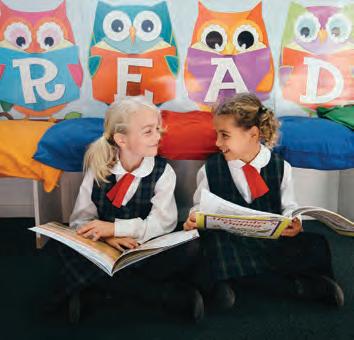
5READ READ READ to and with your child. Show and teach them the front of the book, the back of the book. Point to the words as you read so that they can see the reason for the black squiggly things on the page. Teach them that these are WORDS and WORDS are made of LETTERS. Encourage them to recognize their own name in print and encourage them to write it for themselves. Write their name in DOTS for them to trace, make individual cards for each letter of their name and have them place them in the correct order for their name. 6 Minimise screen time so that they do not lose the ability to communicate effectively with you. Child development experts recommend limiting childrens’ daily screen time. This is because real-life interactions with you and others are much better for your child’s wellbeing, learning and development. At our school we find that children are better equipped to entertain themselves and play imaginatively when screens are not as often made readily available. 7 Concentration is a necessary ingredient for success at school. I suggest you aim for at least one minute per year of your child’s age. This means if your child is 4, you should expect at least 4 minutes of focused concentration on one task. (This does not include screen time). Slowly encourage them to do something and stay focused on the task while you walk away. Start with one minute at first and build up the time slowly. This task could be playdough, Lego, colouring, painting, drawing. 8 Use your family meal times as opportunities for talking and listening learning opportunities. Our children need to learn the skill of waiting your turn to speak so you can play conversational games to help them learn this skill. School is full of talking and listening opportunities and it is beneficial for your child to have the basics before starting school. 9 You can also begin to develop appropriate social skills with your child: taking turns, sharing toys and books, waiting your turn, packing things up, putting toys away, being helpful and helping the adults at home with simple
chores and tasks so they understand the importance of working together. 10 Separation anxiety can also suddenly arise when starting school. You can prepare them for this by leaving your child with another loved one whilst you take some time out. When your little one starts school, they will be separated from you for 5 days per week and for 6 hours each day. Use the time now to help to prepare them for this change. 11 Begin to teach your child how best to respond to a child who may say or do something that makes them feel unsafe. Teach them to loudly stay “STOP” when someone is being unkind. Sometimes the “stop” hand signal is also useful when combined with loudly saying STOP as it sends a clear message that the behaviours are unwanted. Teach your little one to get help from a trusted adult if the behaviours continue. In most schools, the teachers on playground duty or supervision will wear a Hi-vis vest to ensure children can easily and quickly locate them. Encourage your child to get help when they need it. 12 START EARLY to avoid the “scrambling start” - Start planning for the change in routine that school will bring into your life. Your chosen school will provide some playground supervision before school each morning. Find out what time this starts and plan your morning around that time. For your child, arriving at school 5-10minutes before the morning bell sounds is ideal. It means your child has had time to separate from you, put their school bag in the appropriate place and engage with school mates before the day’s learning begins. This means that they are much more likely to be relaxed and ready for the learning challenges that they are about to step into. If you have to get to work, or drop off other children start now to put a plan together about how you will do that in a calm and relaxed timeframe. You may have to take the pressure off yourself by getting some extra help from a trusted friend or family member. Connecting with other parents of children at your chosen school can sometimes result in a carpooling arrangement, which means the drop off and pick up load is shared amongst a few families. 13 Have your child’s vision and hearing tested to ensure there are no physical needs which can be resolved BEFORE starting school. Talk to your family GP about the best way to arrange this. If others find your child’s speech is difficult to understand it would be wise to consult a Speech pathologist for some activities to practise before starting school. If he/she cannot be understood by peers and teachers it could create unnecessary difficulties in the classroom and playground. 14 Most schools will provide you with some opportunities to visit the school in the term before starting school. These visits are often called Orientation Days and are extremely valuable for both yourself and your child. Some schools also accommodate more casual visits earlier in the year. These visits are valuable because you and your child can begin to learn where the important facilities are – bubblers, toilets, classroom, bag racks, pick up and drop off zones, First Aid or Sick Bay rooms, School office, playgrounds and play equipment are just some of

the things you both need to be able to locate and understand the “rules” around them. 15 Meeting the teacher is one of the final steps towards successful integration to school. Your child’s teacher will become an important character in your child’s development. It is not uncommon to hear a child quote their teacher to you and parents have often told me that their little one has challenged or even corrected them citing what “Mrs Jones says…..”Your child’s teacher will instinctively share their personal values with your child. This is a natural component of a teacher who is called to both lead and guide their students. At our School we strongly believe that our teachers are working with parents to help build a FOUNDATION FOR LIFE so that their child is equipped to be a responsive and responsible citizen of the future. Sharing their Christian values with the students that they teach is a critical element for this.
When you are choosing a school for your child you are making one of the most important decisions for both yourself and your little one. Your chosen school will become a part of your daily life and will influence your social, emotional, spiritual and intellectual spheres. You will make friends because of school and your child will do likewise. We know it is important to choose our friends wisely and good friends are those who love, encourage and support us and are able to challenge us when they see us making unwise choices. You want to surround yourself with people who will help you, not hinder you and you will want this for your little one as well.
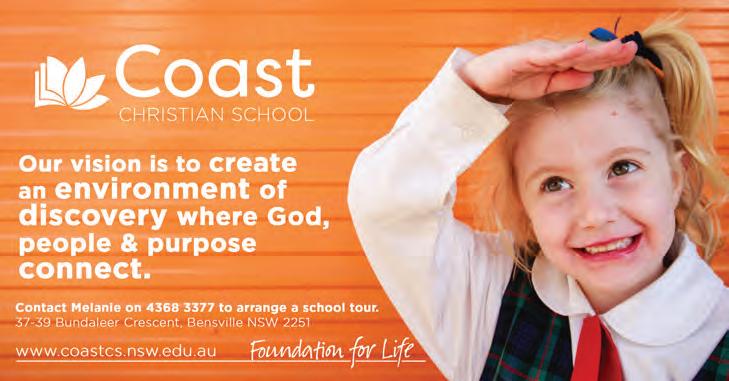
Clare Marcangelo REGISTERED NUTRITIONIST Caring, practical treatment plans for your family. Specialising in childhood behavioural issues, learning and anxiety. Working with families for over 20 years
COVERED BY MOST PRIVATE HEALTH FUNDS Phone 0404 795 677 to book or go to www.erinanutrition.com.au FOR MORE INFORMATION ATMS29747 ABN 89456352713
It's Cool to Connect Cool Connections in School Program
A group of students filled with energy and excitement run in to the classroom. Sitting in a circle, some smile, while others have their heads down and the apprehension of the unknown brings butterflies to their stomachs. Creative materials are set up on activity table ready for the first session of the eight-week Cool Connections program, which is all about the connection and belonging. Curious, a couple of them ask, “what are we doing here?”
The connection begins. The students let their individuality and creativity go wild with unique projects they show off with pride. They all share resources, encouraging each other and voicing thoughts and ideas, watching and learning creative techniques along the way.
Each session starts in the ‘sharing circle’ with each student (including facilitators) telling the group about something positive that happened in last week, creating a positive mindset for the session. They see the similarities and relax. Showing off dance moves, laughing and ‘me too’ moments connect them all as they create together. Then students are encouraged to use their new journals to reflect on something they liked and learnt about, before heading back to class. Cool Connections in School has a focus on achieving the ‘Seven Cs of Resilience’ - Competence, Confidence, Connection, Character, Contribution, Coping and Control.
The program, delivered to Year 5 and Year 6 students, has proven to enhance these areas and achieve positive selfworth, generate a sense of connectedness to teachers and peers, for students who have attended.
Research shows the key attributes of resilience in children and young people include social competence, optimism, a sense of purpose or hope for the future, connection to family, to school and to BY NIKKI SZABO
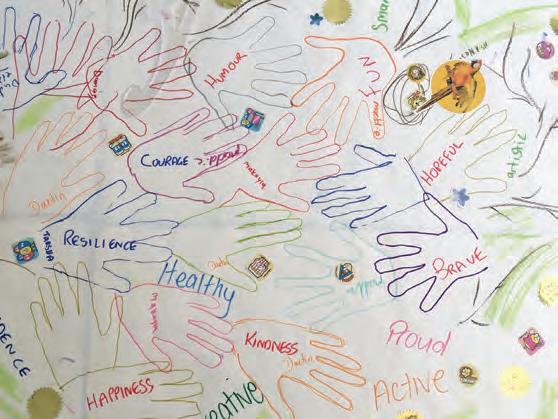
learning, problem-solving skills, effective coping skills, understanding of their values, and positive self-regard.
In our modern world, there are a range of external influences that have an impact on children and young people. Social media, bullying, family breakdown, poor diet, body image pressures and the pressure of success. These types of concerns are often raised by the students in the sharing circles and are also addressed in the session topics allowing the experienced facilitators to encourage safe, open conversation, brainstorm problems-solving ideas to address any concerns. Any major issues are communicated directly to the school for further consideration or action.
The eight-week program was initially developed to address issues such as social exclusion, anxiety, and low self-esteem, but now covers a broader scope. In 2018, 21 programs were delivered to Central Coast primary schools. The impact of the Cool Connections program can be seen by teachers and by the participants themselves.
“To observe a group of students, go from being really reserved, nervous and withdrawn, to this open group of kids, talking about their feelings and sharing insights, has been beyond a highlight for me,” Blue Haven Public School teacher Claudia Campbell said. From the students: I can talk to people easier. I am more confident’ ‘I am much happier, happier than I have been in a really long time’ ‘I am more positive about myself. Now I can stand up to people’ ‘I am happier , I don’t cry myself to sleep as much as I use to and I am braver’ ‘When people say negative things, I don’t get as upset’ ‘I loved the way you always told us to find our bright side because I think I found it.’ ‘Thank you for everything you do, you have taught me to use my imagination, to create.’
Cool Connections in School was developed and is facilitated by Iris Foundation, a local charity which works to build hope, resilience and connections in the community.
More information is available on direct request from schools to Executive Officer, Sue Liptrott – email enquiries@irisfoundation.org.au.

on the coast happenings
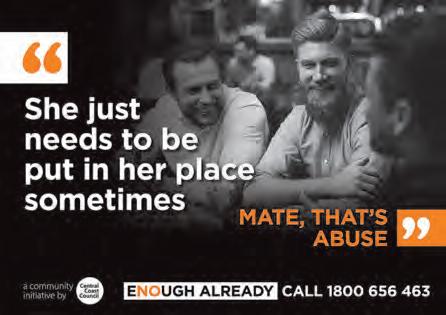
Dad’s Day Out Northern Lakes Neighbourhood Centre presents

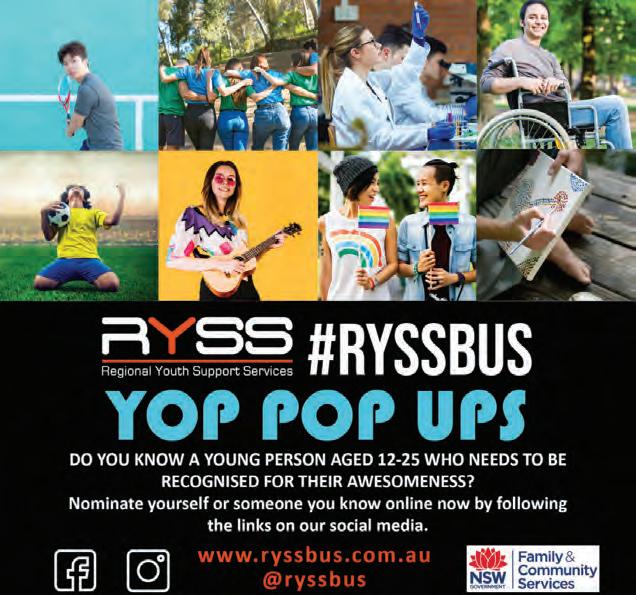
10th Birthday Celebrations!
Celebrating the important role that men play in the lives of their children & family
• Face Painting • The Clenton Inc. Yadaki & Dance Mob • Ninja Warrior Course • Balloon Animals • Kinder Farm (baby animals) • Sand Art • Fishing activities • Ashayne Fitnesssoccer, races, volley ball • Tug of war • Family Photo Booth • Badge making • Pet rocks • Fran’s Plaster Fun • Spray tattoos • Free BBQ and $1 cold drinks available • Drumming • The Fun Engine • Giant Connect 4 ...Plus much more!
Sun Sept 10am - 2pm 22
Lake Munmorah Reserve Colongra Bay Road (Held in the hall if raining)
This is a family friendly, community safe, accessible & alcohol free event
An advertising campaign urging men to call out friends’ abusive behaviour towards women has launched across the Central Coast. The campaign – called Enough Already – will roll out across billboards, bus shelters, bins and social media with a call to action to stop domestic violence. Domestic violence can be verbal or physical, and is all about control. A mate should encourage other men to call out disrespect towards women. Council Acting Director Connected Communities, Phil Cantillon, said the campaign arose from round-table discussions with key organisations seeking to reduce domestic violence on the Coast. “Input from these round-table talks informed this campaign to help shift long-held attitudes surrounding disrespectful behaviour towards women,” Mr Cantillon said. “Statistics show the Central Coast had the second-highest number of domestic violence Apprehended Violence Orders in figures (NSW Bureau of Crime Statistics and Research – BOCSAR) issued for the 12 months to March 2019. “Council wants to see this statistic decrease. This campaign gets behind the numbers, to focus on the lives of ordinary people and helps us to help our friends create better family relationships. “The data is in. Children living with domestic violence can have ongoing anxiety and depression, difficulty concentrating and can struggle doing schoolwork.” Mayor Jane Smith said part of Council’s role is to work together with other government agencies and local organisations to build stronger and safer communities. “Council has been working with respected experts in this area, creating a strong message. We all have a responsibility to reach out and help support our community,” Mayor Smith said “Council has an important role to play in helping resolve social issues that impact on community wellbeing. “This includes domestic violence. We want the Central Coast to be a safe place to live.” Programs are available for men who have either been a victim of family violence, or are seeking to understand their behaviour’s impact and make changes. These include Caring Dads run by CatholicCare Diocese of Broken Bay. Contact 4356 2600 for more information on this program. Women who are seeking support for family violence can call the NSW Domestic Violence Line on 1800 656 463.

Saturday 21st September 9am - 2pm Craft Stalls Live Entertainment Vintage Car Display Haunted House Face Painting Petting Zoo Jumping Castle BBQ & Food Vans Performance from Kids
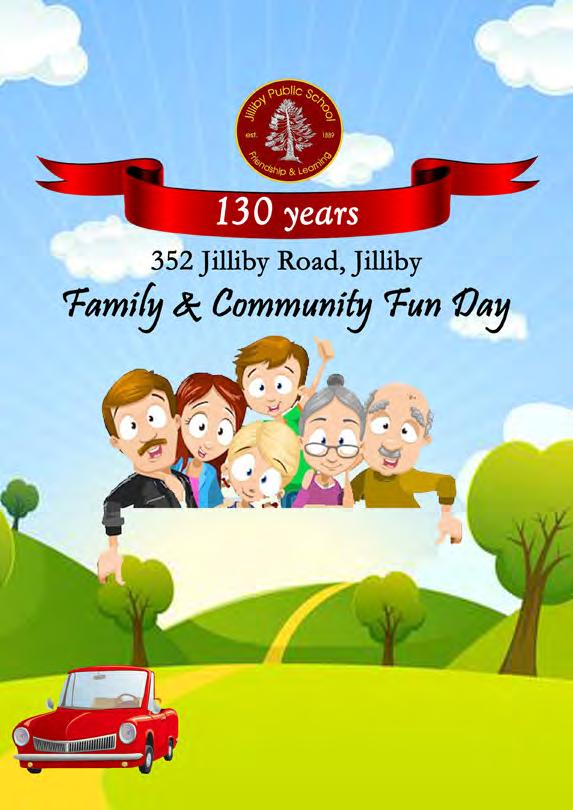










NEW SENSORY PLAY SPACE IN POINT CLARE
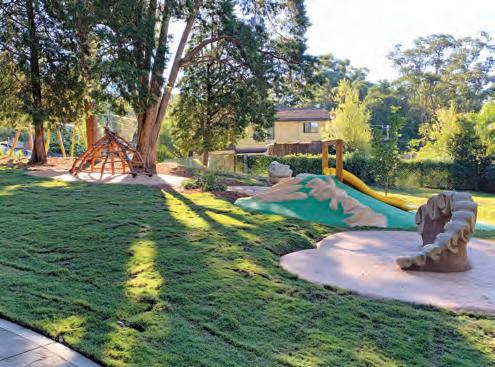
Children visiting Point Clare will have the opportunity to enjoy an inclusive, peaceful and sensory play experience thanks to a new upgrade to the Wendy Drive play space delivered by Central Coast Council.
Councils improvement works at the new Dinosaur themed play space have been designed to encourage the imagination of small visitors and accommodate the needs of children on the Autism spectrum, with complete perimeter fencing combined with a low canopy of trees providing a sense of a secure space within a defined boundary.
Mayor Jane Smith said the revitalisation of the Wendy Drive play space has created an inclusive recreational space that brings the community together and promotes healthy lifestyles. “This collaborative project demonstrates our commitment to providing inclusive spaces and opportunities for all people to feel welcome and participate in community life,” Mayor Smith said.
The $145,000 upgrade project was jointly funded by Central Coast Council and NSW Government’s Community Building Partnership program and includes a double slide, basket swing and dinosaur fossils and footprints throughout the rubber softfall sparking the imagination of small visitors to be on the lookout for a T-Rex or Velociraptor.
Visitors to the play space will also find some beautifully hand crafted timber seats to rest on as they pass through the park, with a natural branch climber linked back to the resident who owned and donated the land to Council.
